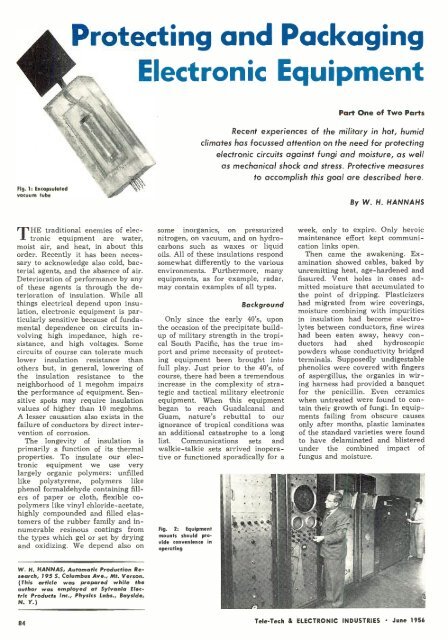TELE-TECH & - AmericanRadioHistory.Com
TELE-TECH & - AmericanRadioHistory.Com
TELE-TECH & - AmericanRadioHistory.Com
Create successful ePaper yourself
Turn your PDF publications into a flip-book with our unique Google optimized e-Paper software.
Protecting and Packaging<br />
Electronic Equipment<br />
Part One of Two Parts<br />
Fig. 1: Encapsulated<br />
vacuum tube<br />
Recent experiences of the military in hot, humid<br />
climates has focussed attention on the need for protecting<br />
electronic circuits against fungi and moisture, as well<br />
as mechanical shock and stress. Protective measures<br />
to accomplish this goal are described here.<br />
By W. H. HANNAHS<br />
THE traditional enemies of electronic<br />
equipment are water,<br />
moist air, and heat, in about this<br />
order. Recently it has been necessary<br />
to acknowledge also cold, bacterial<br />
agents, and the absence of air.<br />
Deterioration of performance by any<br />
of these agents is through the deterioration<br />
of insulation. While all<br />
things electrical depend upon insulation,<br />
electronic equipment is particularly<br />
sensitive because of fundamental<br />
dependence on circuits involving<br />
high impedance, high resistance,<br />
and high voltages. Some<br />
circuits of course can tolerate much<br />
lower insulation resistance than<br />
others but, in general, lowering of<br />
the insulation resistance to the<br />
neighborhood of 1 megohm impairs<br />
the performance of equipment. Sensitive<br />
spots may require insulation<br />
values of higher than 10 megohms.<br />
A lesser causation also exists in the<br />
failure of conductors by direct intervention<br />
of corrosion.<br />
The longevity of insulation is<br />
primarily a function of its thermal<br />
properties. To insulate our electronic<br />
equipment we use very<br />
largely organic polymers: unfilled<br />
like polystyrene, polymers like<br />
phenol formaldehyde containing fillers<br />
of paper or cloth, flexible copolymers<br />
like vinyl chloride- acetate,<br />
highly compounded and filled elastomers<br />
of the rubber family and innumerable<br />
resinous coatings from<br />
the types which gel or set by drying<br />
and oxidizing. We depend also on<br />
some inorganics, on pressurized<br />
nitrogen, on vacuum, and on hydro-.<br />
carbons such as waxes or liquid<br />
oils. All of these insulations respond<br />
somewhat differently to the various<br />
environments. Furthermore, many<br />
equipments, as for example, radar,<br />
may contain examples of all types.<br />
Background<br />
Only since the early 40's, upon<br />
the occasion of the precipitate buildup<br />
of military strength in the tropical<br />
South Pacific, has the true import<br />
and prime necessity of protecting<br />
equipment been brought into<br />
full play. Just prior to the 40's, of<br />
course, there had been a tremendous<br />
increase in the complexity of strategic<br />
and tactical military electronic<br />
equipment. When this equipment<br />
began to reach Guadalcanal and<br />
Guam, nature's rebuttal to our<br />
ignorance of tropical conditions was<br />
an additional catastrophe to a long<br />
list. <strong>Com</strong>munications sets and<br />
walkie- talkie sets arrived inoperative<br />
or functioned sporadically for a<br />
Fig. 2: Equipment<br />
mounts should provide<br />
convenience in<br />
operating<br />
week, only to expire. Only heroic<br />
maintenance effort kept communication<br />
links open.<br />
Then came the awakening. Examination<br />
showed cables, baked by<br />
unremitting heat, age- hardened and<br />
fissured. Vent holes in cases admitted<br />
moisture that accumulated to<br />
the point of dripping. Plasticizers<br />
had migrated from wire coverings,<br />
moisture combining with impurities<br />
in insulation had become electrolytes<br />
between conductors, fine wires<br />
had been eaten away, heavy conductors<br />
had shed hydroscopic<br />
powders whose conductivity bridged<br />
terminals. Supposedly undigestable<br />
phenolics were covered with fingers<br />
of aspergillus, the organics in wiring<br />
harness had provided a banquet<br />
for the penicillin. Even ceramics<br />
when untreated were found to contain<br />
their growth of fungi. In equipments<br />
failing from obscure causes<br />
only after months, plastic laminates<br />
of the standard varieties were found<br />
to have delaminated and blistered<br />
under the combined impact of<br />
fungus and moisture.<br />
W. H. HANNAS, Automatic Production Research,<br />
195 S. Columbus Ave., Mt. Verson.<br />
(This article was prepared while the<br />
author was employed at Sylvania Electric<br />
Products Inc., Physics Labs., Bayside,<br />
N. Y.)<br />
84<br />
Tele -Tech & ELECTRONIC INDUSTRIES June 1956
















